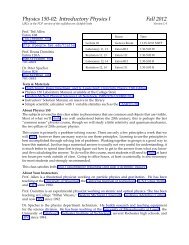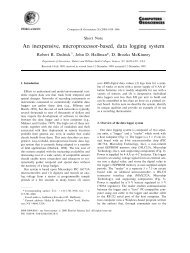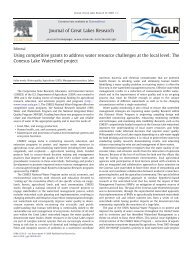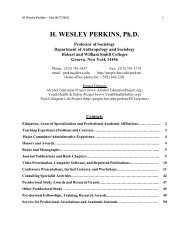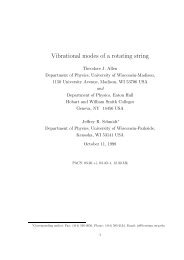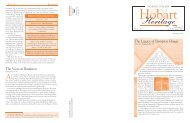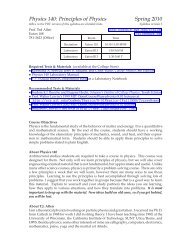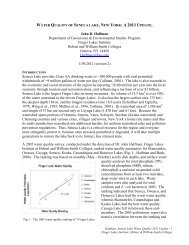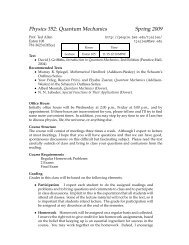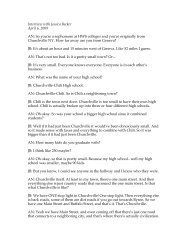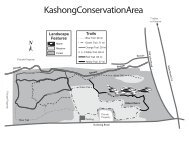Geology of New Zealand Field Trip Guidebook - ResearchGate
Geology of New Zealand Field Trip Guidebook - ResearchGate
Geology of New Zealand Field Trip Guidebook - ResearchGate
You also want an ePaper? Increase the reach of your titles
YUMPU automatically turns print PDFs into web optimized ePapers that Google loves.
strong beaks they can do considerable damage. For example, they will strip all the trim and<br />
rubber <strong>of</strong>f a car! They are also attracted to shiny objects like watches, glasses and jewelry.<br />
The <strong>New</strong> <strong>Zealand</strong> Department <strong>of</strong> Conservation website claims that most Kea are good birds,<br />
and the majority <strong>of</strong> damage is caused by a few “problem birds.” They have a banding<br />
program to identify and help deal with these miscreants! They also note that problems with<br />
Kea are greatly increased in areas where humans feed the birds. Please refrain from doing<br />
so! Also, many birds are accustomed to people and quite bold. While this may seem like an<br />
ideal opportunity for some up-close and personal with the wildlife—Beware! You find<br />
yourself in a wrestling match over your camera, watch or necklace with a set <strong>of</strong> sharp claws<br />
and powerful beak. My money’s on the kea.<br />
[f\<br />
Day 7—Thursday 20 November. We’ll begin the day with a short walk up to some<br />
spectacular waterfalls above the village <strong>of</strong> Arthur’s Pass. This will give you another look at<br />
the high elevation, wet beech forest. Mostly it’s just picturesque and a chance to get the<br />
blood moving before another big day <strong>of</strong> travel.<br />
As we leave Arthur’s Pass on the bus, watch for glacial landforms, such as U-shaped<br />
valleys, hanging valleys, moraines, etc. Also note the nature <strong>of</strong> some <strong>of</strong> the large streams—<br />
braided channels choked with sediment. This is the stuff <strong>of</strong> which the coastal plain near<br />
Christchurch is built.<br />
Stop 1: Kura Tawhiti Conservation Area—Castle Hill<br />
We will do a short hike here to look at some rocks that are very different from the dark<br />
colored, laminated Torlesse rocks visible in most <strong>of</strong> the hills. The rocks we see here are in a<br />
down-faulted inlier <strong>of</strong> younger Cretaceous to Tertiary rocks. As you look around, consider<br />
not only what you can see underfoot, but also the surrounding hills.<br />
Notebook Assignment: What kind <strong>of</strong> rock is this? The outcrops here have very different<br />
“shapes” to what we have seen elsewhere. Why? This rock is younger than the Torlesse<br />
rocks. Compare the amount and character <strong>of</strong> deformation <strong>of</strong> these rocks to that in the<br />
Torlesse group. What is going on?<br />
Given the striking nature <strong>of</strong> the landscape here, it is not surprising that it is also an important<br />
Maori cultural site associated with Maori myths and rock art. The spot was an important<br />
stopover on the greenstone trade routes to the West coast and today has protection as an<br />
important Maori cultural site. Visitors are asked to stay <strong>of</strong>f the rocks in respect for the site’s<br />
cultural significance.<br />
Stop 2: Torlesse Range Pullout<br />
The rocks exposed here are near the type section <strong>of</strong> the Torlesse Supergroup [Sugate, 1961<br />
#11], a kilometers thick pile <strong>of</strong> interbedded greywackes (sandstones with rock fragments and<br />
a clay rich matrix) and shales that range in age from late Paleozoic through Mesozoic.<br />
Rocks like these outcrop over about a quarter <strong>of</strong> the South Island in an elongate belt along the<br />
Southern Alps. To the east they are unconformably overlain by later deposits. To the west<br />
they grade into the Haast Schist, a metamorphosed equivalent. Torlesse rocks are notoriously<br />
difficult to work with—they are <strong>of</strong> unknown age but huge thickness, contain few distinctive<br />
lithologies or marker beds, are rarely fossiliferous and are strongly deformed. In this area,<br />
Torlesse rocks are mapped as Triassic and Jurassic (Suggate 1978) in age (early to middle<br />
Mesozoic). The rock types we see here are typical <strong>of</strong> Torlesse, but elsewhere these<br />
28




